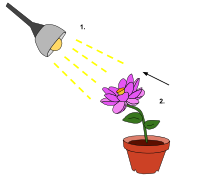Types of Stimuli
- Stimulus is a detectable change in the physical or chemical structure of an organism's environment
- Light from a lamp functions as a detectable change in the plant's environment
- Plants exhibit phototropism, which is directional growth toward the light stimulus
- Sensory receptors can receive information from outside and inside the body
- Stimulus transduction can elicit reflexes and trigger homeostatic control systems
Internal Stimuli
- Homeostatic imbalances are monitored by receptors and sensors in the body
- Mechanoreceptors, chemoreceptors, and thermoreceptors respond to pressure, chemical changes, and temperature changes
- Internal stimuli include nutrient and ion levels, oxygen levels, and water levels
- Deviations from homeostasis can generate homeostatic emotions like pain, thirst, or fatigue
- Behavior is motivated to restore the body to stasis, such as withdrawal, drinking, or resting
External Stimuli
- Sensory feelings, especially pain, elicit a large response and cause neurological changes
- Sensory receptors on the skin detect pain and transmit signals to the central nervous system
- Nociceptors are pain receptors, including A-fiber and C-fiber nociceptors
- Absolute threshold for touch is the minimum amount of sensation needed to elicit a response
- Vision allows the brain to perceive and respond to changes through light stimuli
Sensory Systems
4.1 Vision
- Light enters the retina and excites photoreceptor cells
- Local graded potential starts in the photoreceptor and passes along neurons to the CNS
- Action potentials are created for the signal to reach the CNS
- Visual information is processed in the occipital lobe's primary visual cortex
- Absolute threshold for vision is the minimum amount of sensation needed to elicit a response from photoreceptors
4.2 Smell and Taste
- Smell allows recognition of chemical molecules in the air through inhalation
- Olfactory organs contain olfactory receptor cells and interact with odorant-binding proteins
- Odorants bind to G protein-coupled receptors, activating adenylate cyclase
- Absolute threshold for smell is the minimum amount of sensation needed to elicit a response from receptors in the nose
- Taste records flavoring of food and other materials that pass across the tongue and through the mouth
Neuronal Communication and Responses
- Excitatory neurons release excitatory neurotransmitters, causing a response in the postsynaptic neuron
- Neurons communicate with thousands of other receptors and target cells through complex dendritic networks
- Localised graded potentials trigger action potentials that travel along nerve axons to specific cortexes of the brain
- Inhibitory neurons release inhibitory neurotransmitters, leading to an inhibitory postsynaptic potential
- Neurons can be either excitatory or inhibitory depending on the type of stimulus
Note: The content has been organised into 5 comprehensive groups, combining identical concepts while keeping facts, statistics, and detailed points intact.
In physiology, a stimulus is a detectable change in the physical or chemical structure of an organism's internal or external environment. The ability of an organism or organ to detect external stimuli, so that an appropriate reaction can be made, is called sensitivity (excitability). Sensory receptors can receive information from outside the body, as in touch receptors found in the skin or light receptors in the eye, as well as from inside the body, as in chemoreceptors and mechanoreceptors. When a stimulus is detected by a sensory receptor, it can elicit a reflex via stimulus transduction. An internal stimulus is often the first component of a homeostatic control system. External stimuli are capable of producing systemic responses throughout the body, as in the fight-or-flight response. In order for a stimulus to be detected with high probability, its level of strength must exceed the absolute threshold; if a signal does reach threshold, the information is transmitted to the central nervous system (CNS), where it is integrated and a decision on how to react is made. Although stimuli commonly cause the body to respond, it is the CNS that finally determines whether a signal causes a reaction or not.
